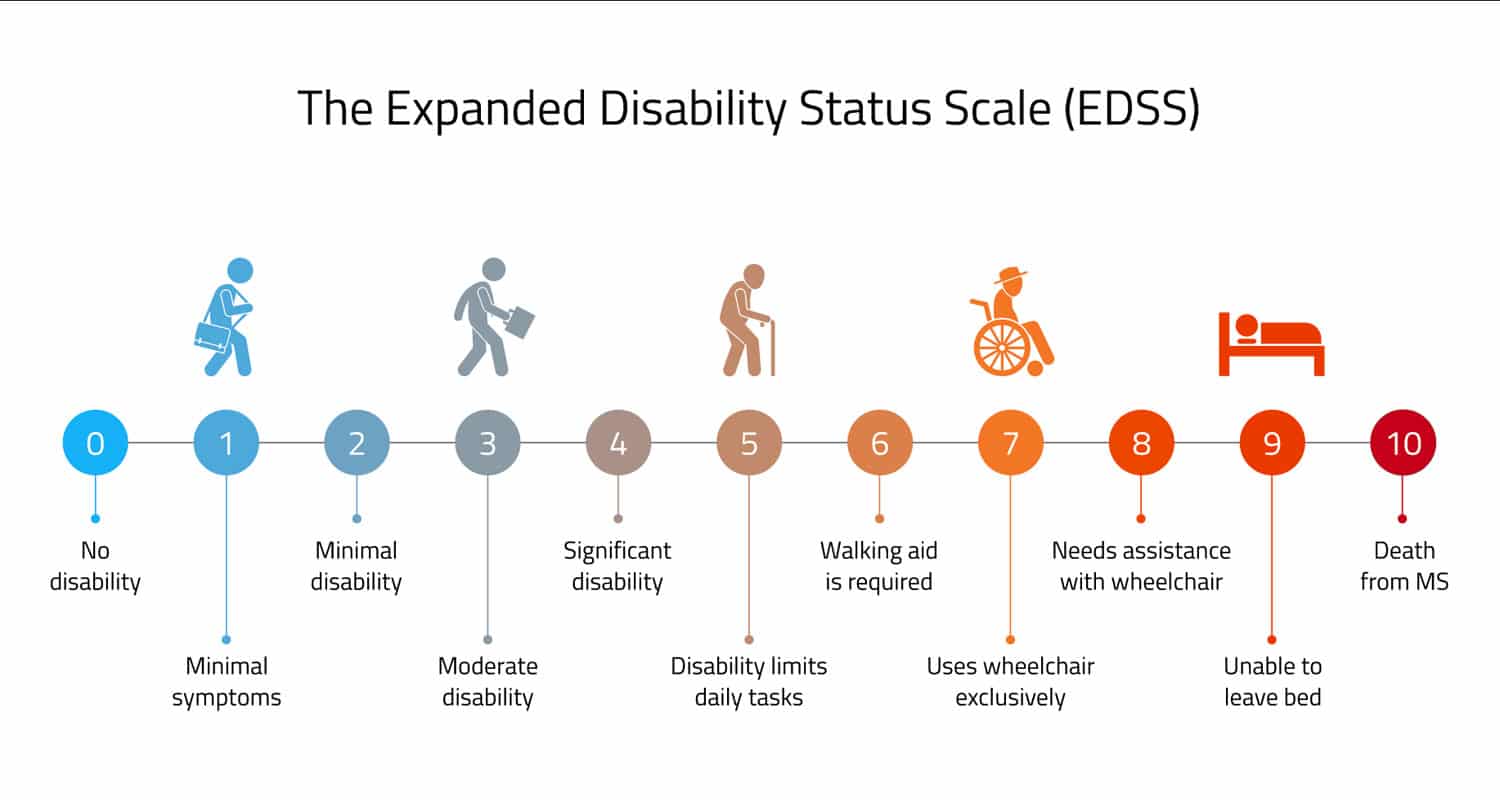Edss
Expanded Disability Status Scale (EDSS)
The Expanded Disability Status Scale (EDSS) is a method of quantifying disability in multiple sclerosis and monitoring changes in the level of disability over time. It is widely used in clinical trials and in the assessment of people with MS.
The scale was developed by a neurologist called John Kurtzke in 1983 as an advance from his previous 10 step Disability Status Scale (DSS). The EDSS scale ranges from 0 to 10 in 0.5 unit increments that represent higher levels of disability. Scoring is based on an examination by a neurologist.

To be eligible for HSCT Treatment in India the patient’s EDSS score should be less than 7.
EDSS Score Description
| 0.0 | Normal neurological examination |
| 1.0 | No disability, minimal signs in one FS |
| 1.5 | No disability, minimal signs in more than one FS |
| 2.0 | Minimal disability in one FS |
| 2.5 | Mild disability in one FS or minimal disability in two FS |
| 3.0 | Moderate disability in one FS, or mild disability in three or four FS. Fully ambulatory |
| 3.5 | Fully ambulatory but with moderate disability in one FS and more than minimal disability in several others |
| 4.0 | Fully ambulatory without aid, self-sufficient, up and about some 12 hours a day despite relatively severe disability; able to walk without aid or rest some 500 meters |
| 4.5 | Fully ambulatory without aid, up and about much of the day, able to work a full day, may otherwise have some limitation of full activity or require minimal assistance; characterized by relatively severe disability; able to walk without aid or rest some 300 meters. |
| 5.0 | Ambulatory without aid or rest for about 200 meters; disability severe enough to impair full daily activities (work a full day without special provisions) |
| 5.5 | Ambulatory without aid or rest for about 100 meters; disability severe enough to preclude full daily activities |
| 6.0 | Intermittent or unilateral constant assistance (cane, crutch, brace) required to walk about 100 meters with or without resting |
| 6.5 | Constant bilateral assistance (canes, crutches, braces) required to walk about 20 meters without resting |
| 7.0 | Unable to walk beyond approximately five meters even with aid, essentially restricted to wheelchair; wheels self in standard wheelchair and transfers alone; up and about in wheelchair some 12 hours a day |
| 7.5 | Unable to take more than a few steps; restricted to wheelchair; may need aid in transfer; wheels self but cannot carry on in standard wheelchair a full day; May require motorized wheelchair |
| 8.0 | Essentially restricted to bed or chair or perambulated in wheelchair, but may be out of bed itself much of the day; retains many self-care functions; generally has effective use of arms |
| 8.5 | Essentially restricted to bed much of day; has some effective use of arms retains some self care functions |
| 9.0 | Confined to bed; can still communicate and eat. |
| 9.5 | Totally helpless bed patient; unable to communicate effectively or eat/swallow |
| 10.0 | Death due to MS and just above Real Patient– Real Stories |
Answers To Frequently Asked Questions (FAQs) about HSCT for MS at HSCT Hospital India
- What is the Expanded Disability Status Scale (EDSS)?
- How is the EDSS score determined
- What does each EDSS score mean ?
- What is the difference between EDSS and other disability scales ?
- Who administers the EDSS assessment ?
- How often should EDSS assessments be done ?
- Can the EDSS score change over time ?
- How is EDSS used in treatment planning ?
- Can the EDSS score be influenced by other factors, like age or co-existing conditions ?
- How can I prepare for an EDSS assessment ?
- Can EDSS be used to predict disease progression ?
- Is the EDSS used worldwide ?
- Can the EDSS score be reversed or improved ?
1. What is the Expanded Disability Status Scale (EDSS)?
The Expanded Disability Status Scale (EDSS)—often referred to as the gold standard in measuring disability—is a tool that healthcare professionals rely on to gauge the severity of impairment in patients with neurological conditions, most notably multiple sclerosis (MS). This scale, designed with precision, captures a patient’s neurological function through various aspects: mobility, vision, coordination, and beyond. It’s more than just a number; it’s the window into understanding how the disease is progressing—and how far it’s taking its toll.
2. How is the EDSS score determined ?
The EDSS score isn’t something you simply pull from a chart. No, it’s the culmination of a meticulous neurological examination, performed by a skilled healthcare provider. This exam examines mobility, coordination, vision, and sensation. The scale itself is a journey from 0 to 10—where 0 signifies no disability, and 10 tragically represents death from MS. Each score in between paints a clearer picture of disability, layering details from mild impairments to the most severe.
3. What does each EDSS score mean ?
The EDSS scale uses a variety of scores to indicate different levels of disability. Here’s a quick overview:
- 0: Normal neurological function
- 1.0 to 3.5: Minimal disability
- 4.0 to 5.5: Moderate disability, with some difficulty in mobility or function
- 6.0 to 7.5: Severe disability, requiring assistance with mobility
- 8.0 to 9.5: Very severe disability, needing constant assistance
- 10: Death due to MS
Each score is based on specific criteria such as walking distance, vision, and coordination.
healthcare provider. This exam examines mobility, coordination, vision, and sensation. The scale itself is a journey from 0 to 10—where 0 signifies no disability, and 10 tragically represents death from MS. Each score in between paints a clearer picture of disability, layering details from mild impairments to the most severe.
4. What is the difference between EDSS and other disability scales ?
EDSS is the go-to scale for MS—there’s no denying that. But how does it differ from others? The Multiple Sclerosis Functional Composite (MSFC), for instance, focuses on cognitive ability and other aspects of MS that don’t fit neatly into the physical mold. EDSS, though, zeroes in on the physical manifestations of the disease, particularly how it impacts movement, coordination, and sensory abilities. It’s the scale that tracks physical disability while other scales may measure cognitive or other functions.
5. Who administers the EDSS assessment ?
The EDSS requires the expertise of a trained neurologist or another medical professional experienced in evaluating neurological function. They will test your physical abilities and assess how your body reacts to a battery of functional challenges to determine your score.
6. How often should EDSS assessments be done ?
The frequency of EDSS assessments depends entirely on the individual’s condition and the progression of the disease. For most, regular assessments during routine visits are standard, but if your symptoms are evolving, more frequent assessments might be recommended.
7. Can the EDSS score change over time ?
Yes. In fact, the EDSS score is dynamic, shifting with the ebb and flow of the disease. Disability increases, and the score reflects this, offering an important snapshot of progression. These shifts in scores are crucial for doctors—they signal when to adjust treatment plans or when intervention is needed to slow down further deterioration.
8. How is EDSS used in treatment planning ?
The EDSS score acts as a guiding star for doctors. It provides concrete data that helps shape treatment decisions. If the score suggests that a patient is nearing a more severe stage of disability, doctors may lean toward disease-modifying therapies (DMTs), physical therapy, or other interventions designed to slow progression and manage symptoms.
9. Can the EDSS score be influenced by other factors, like age or co-existing conditions ?
Absolutely. Age, other health conditions, and past treatments can all have an impact on the EDSS results. For example, an older patient may experience different symptoms or progression compared to a younger one. This is why doctors take a holistic view—factoring in medical history—when interpreting the EDSS score to ensure accurate treatment adjustments.
10. How can I prepare for an EDSS assessment ?
Your doctor will ask about any changes in your symptoms or physical abilities. Be prepared to detail any differences since your last visit. This helps ensure that the EDSS assessment is as accurate as possible. But otherwise? Just show up, stay open, and let the exam unfold.
11. Can EDSS be used to predict disease progression ?
It’s a great tool, but it doesn’t predict the future with certainty. While the EDSS can offer insight into how the disease is progressing at the moment, it can’t give you a crystal-clear roadmap for the road ahead. Still, it’s incredibly helpful for adjusting treatments and providing insights into the direction in which the disease may be heading.
12. Is the EDSS used worldwide ?
The EDSS is a global standard. Doctors across the world rely on this scale to track disability in MS patients, using it in clinical trials and research to measure the disease’s impact. It’s an essential tool in the global effort to understand and manage MS.
13. Can the EDSS score be reversed or improved ?
Here’s the tricky part: the EDSS score itself doesn’t reverse or “get better.” However, treatments like disease-modifying therapies (DMTs) or physical therapy can help slow the disease’s progression and, in some cases, even improve mobility or functional ability. Such improvements may not necessarily change the EDSS score drastically, but they can significantly improve quality of life—and that’s a victory in itself.
Real Patient– Real Stories




